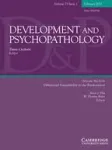[article]
| Titre : |
Genetic and neurocognitive contributions to the development of psychopathy |
| Type de document : |
texte imprimÃĐ |
| Auteurs : |
Essi VIDING, Auteur ; Eamon J. MCCRORY, Auteur |
| AnnÃĐe de publication : |
2012 |
| Article en page(s) : |
p.969-83 |
| Langues : |
Anglais (eng) |
| Index. dÃĐcimale : |
PER Périodiques |
| RÃĐsumÃĐ : |
An overview is provided of recent twin, molecular genetic, and magnetic resonance imaging studies that are helping to inform a model of developmental vulnerability to adult psychopathy. Although the current evidence base suggests that children with high levels of callousâunemotional traits are genetically and neurocognitively vulnerable to developing psychopathic and antisocial behaviors, existing research also clearly indicates that environmental influences play an important role. One potential implication is that interventions for children with antisocial behavior and callousâunemotional traits may need to be tailored to take into account their distinct pattern of neurocognitive vulnerability, as revealed by developmental neuroimaging studies. Specifically, interventions that pursue punishment-oriented or explicit empathy induction strategies may be less effective with this group of antisocial children. By contrast, preliminary evidence suggests that enhancing positive parenting and parental involvement, as well as applying consistent rewards may represent more promising intervention approaches. |
| En ligne : |
http://dx.doi.org/10.1017/S095457941200048X |
| Permalink : |
https://www.cra-rhone-alpes.org/cid/opac_css/index.php?lvl=notice_display&id=178 |
in Development and Psychopathology > 24-3 (August 2012) . - p.969-83
[article] Genetic and neurocognitive contributions to the development of psychopathy [texte imprimÃĐ] / Essi VIDING, Auteur ; Eamon J. MCCRORY, Auteur . - 2012 . - p.969-83. Langues : Anglais ( eng) in Development and Psychopathology > 24-3 (August 2012) . - p.969-83
| Index. dÃĐcimale : |
PER Périodiques |
| RÃĐsumÃĐ : |
An overview is provided of recent twin, molecular genetic, and magnetic resonance imaging studies that are helping to inform a model of developmental vulnerability to adult psychopathy. Although the current evidence base suggests that children with high levels of callousâunemotional traits are genetically and neurocognitively vulnerable to developing psychopathic and antisocial behaviors, existing research also clearly indicates that environmental influences play an important role. One potential implication is that interventions for children with antisocial behavior and callousâunemotional traits may need to be tailored to take into account their distinct pattern of neurocognitive vulnerability, as revealed by developmental neuroimaging studies. Specifically, interventions that pursue punishment-oriented or explicit empathy induction strategies may be less effective with this group of antisocial children. By contrast, preliminary evidence suggests that enhancing positive parenting and parental involvement, as well as applying consistent rewards may represent more promising intervention approaches. |
| En ligne : |
http://dx.doi.org/10.1017/S095457941200048X |
| Permalink : |
https://www.cra-rhone-alpes.org/cid/opac_css/index.php?lvl=notice_display&id=178 |
|  |


